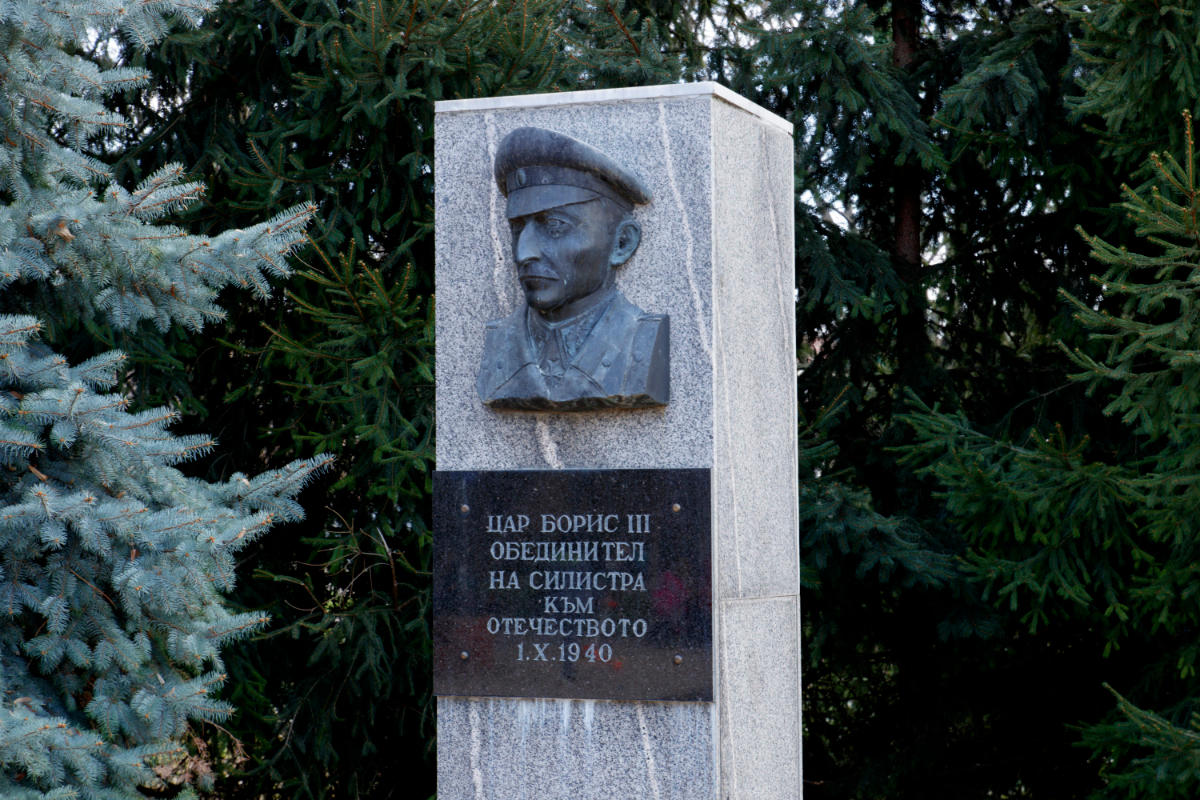Monument to Tsar Boris III
Category MonumentLOCATION
The monument of Tsar Boris III is situated in the Danube Park in the town of Silistra, 429 km away from Sofia. There is a bus three times a day leaving from the Sofia Central Bus Station to Silistra, as well as a train three times a day from the Sofia Central Railway Station.
DESCRIPTION
The monument of Tsar Boris III is a sculpture of bronze material - bust.
HISTORY
The monument of Tsar Boris III, made by the sculptor Yordan Kolev, was opened in 2001. A bust-monument, one of the most popular types of sculptural portraits – an image of a person down to his waist (head, shoulders and torso) placed on a pedestal. The commonly used materials for bust-monuments are marble, bronze, granite.
Tsar Boris III takes the crown at 24 years in an extremely difficult time for the country. The beginning of his reign resembles that of his father, namely he reigns without ruling.
In 1923 the king was placed in an ambiguous position. He had to take a decision either the election or legalization of the government by the military coup of Prof. Alexander Tsankov, or to abdicate. Although without pleasure, Boris III accepts the first alternative. So the Bulgarian Tsar actually started his monarchic career with the sanctioning of an unconstitutional act.
Tsar Boris III is the son of King Ferdinand Saxe-Coburg-Gotha and Queen Maria Louisa. Born on January 30, 1894, in Sofia. He received his secondary education in the Palace of Teachers from the First Male High School. He graduated from the Military School in Sofia. He ascended to the throne at the age of 24 after the abdication of his father in 1918. Boris governed the state during a risky and unstable period - heavy reparations imposed by the Neuilly Treaty, territorial, human and economic losses as a result of the last two wars, and an aggressive anti-monarchical opposition in the face of communists and farmers. A year after his ascension to the throne, the government of Stamboliyski came to power.[1]
During the Balkan and World War I, Boris III participated in the military action. The crown heir had been sent to the front as a liaison officer in the Bulgarian army. He was promoted several times in rank and in 1918. reached the rank of Major General.
In 1941 Tsar Boris III managed to return the territories of Vardar Macedonia and Aegean Thrace to Bulgaria. It is precisely because of this diplomatic success, as well as the return of Northern Dobrudzha, which Bulgaria lost in the Russo-Turkish Liberation War that Boris III reaffirmed his nickname "Unifier". The people became extremely grateful to their monarch.
Tsar Boris III is also called the "savior of the Jews". Under enormous pressure from Hitler, Bulgaria was forced to deport the Jews from the restored territories, as well as a small part of those living in the "old" territories. Since Tsar Boris did not want to participate in the genocide over the Jewish people, he tried to find ways to save those who are under his authority. He got in touch with the UK government with the suggestion that Bulgarian Jews threatened by deportation should be sent by ships to the English-controlled Palestine. However, the monarch's proposal was rejected.
The trial against Eichmann in Jerusalem made it clear that later, Tsar Boris III opposed the order of Germany to deport the Jews from the Kingdom of Bulgaria. In this way he saved them from certain death. These were 50,000 Bulgarian and foreign Jews. By the end of the war some foreign Jews had documents issued by the Bulgarian authorities that they were on vacation for medical purposes. Bulgaria is the only country in which after the Second World War the Jewish population increased in numbers.[2]
The monument of Tsar Boris III in the Danube Garden in Silistra was renovated by students from the Penyo Penev Professional School of Construction in 2013. Then the students renewed the broken tablets of the monument. The building materials were provided by volunteer companies from the city.
Celebrations are held in front of the monument, and the grateful citizens of Silistra put flowers in appreciation.
SITE SIGNIFICANCE
Tsar Boris III is called the "savior of the Jews" and "the favorite of the Bulgarians". The monument is a symbol of gratitude to the Bulgarian Tsar, who ruled in some of the most difficult times for Bulgaria.
VISITOR INFORMATION
It is located outside and is free to visit.
SITE CLASSIFICATION
Monumental monument
[1] Edinzavet.wordpress.com <https://edinzavet.wordpress.com/pridvorni/boris3/> (24.04.2018)
[2] Bulgarianhistory.org <https://bulgarianhistory.org/car-boris/> (24.04.2018)




